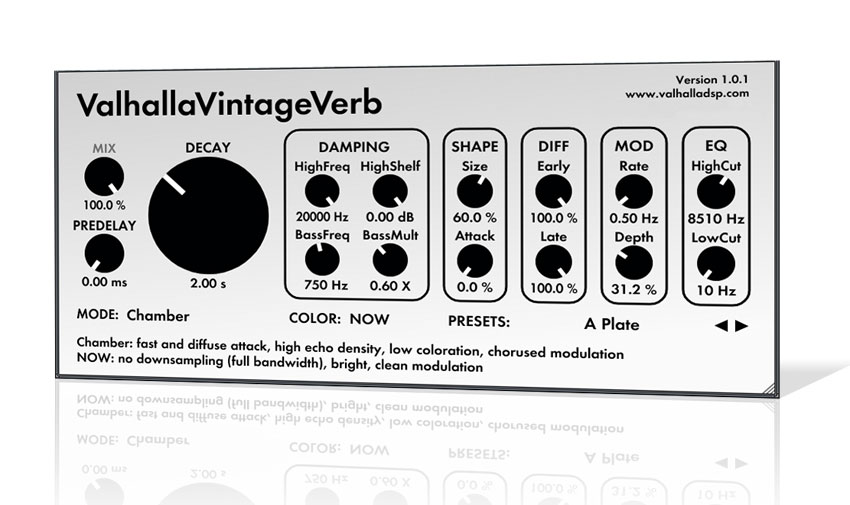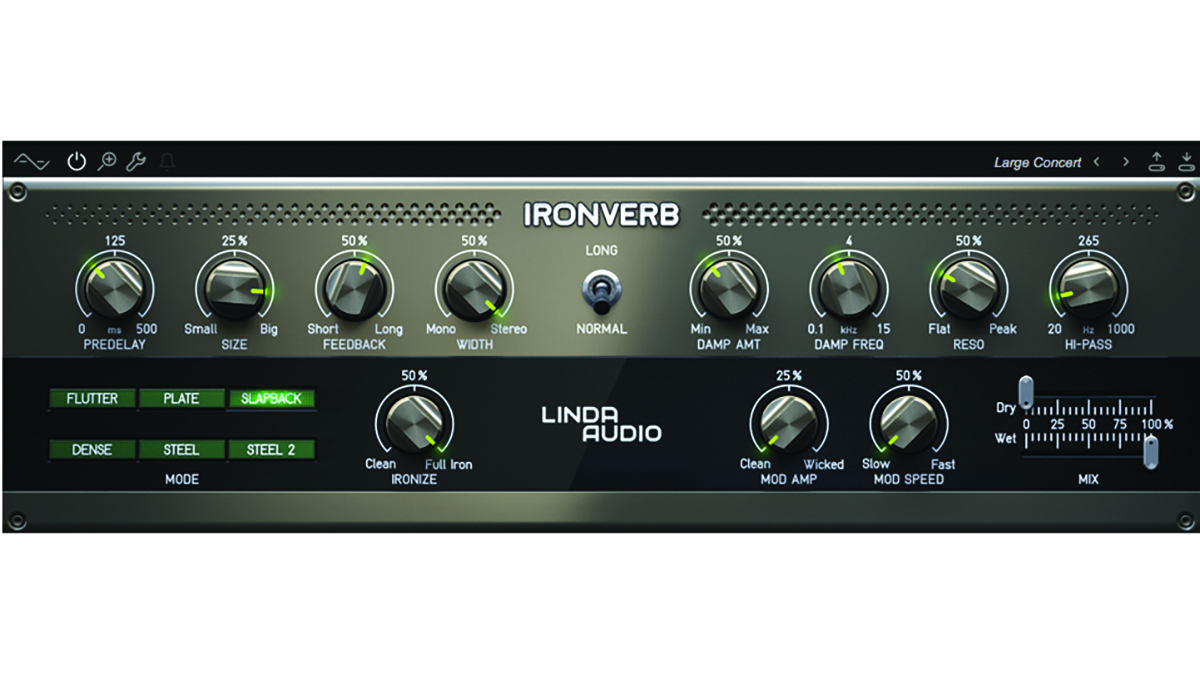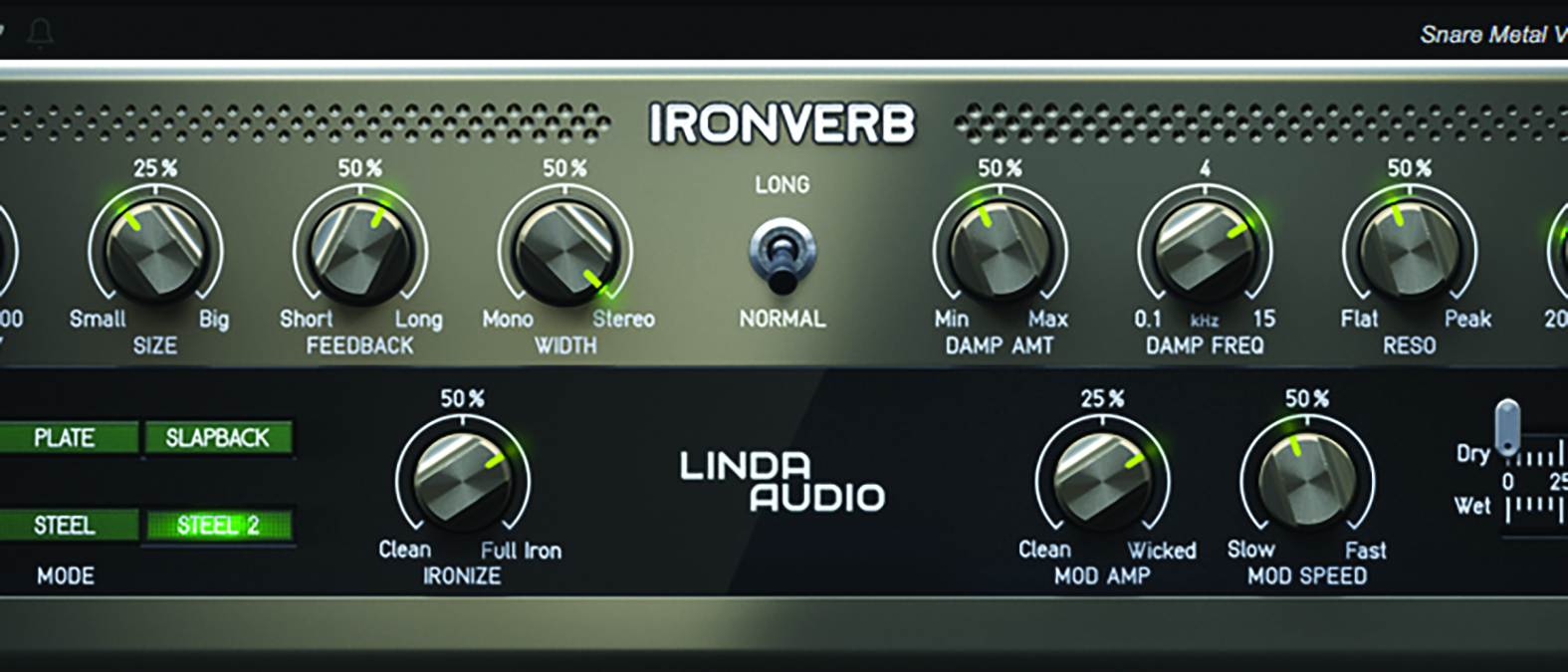MusicRadar Verdict
Linda IronVerb is definitely not a do-it-all processor, but if you’re after a flavour-packed reverb capable of some pretty extreme outcomes, this could be for you.
Pros
- +
Simple interface.
- +
Choice of six algorithms.
- +
Powerful and unusual Ironize control.
- +
Great for flavoursome reverb effects.
Cons
- -
Limited advanced editing parameters on offer.
MusicRadar's got your back
Audified Linda IronVerb: What is it?
Linda IronVerb (AU, AAX, VST3) is an algorithmic reverb and is the second plugin developed by Audified in collaboration with mixing and mastering engineer Martin Linda.
The reverb features a number of familiar parameters including Size, Predelay, Modulation and Damping, and at its core are six quite distinctive algorithms (Flutter, Plate, Slapback, Dense, Steel and Steel 2) as well as two room size options (Normal and Long). The plugin takes its name from a rather intriguing adjustable modulation parameter, Ironize, that imparts a smooth metallic character to the sound.

Audified Linda IronVerb: Performance and verdict
Before we look at how the Ironize option sounds in use, it’s worth saying that IronVerb’s focused feature set is incredibly straightforward to use. Over on the left you can adjust the core algorithm. Size settings vary from Small to Big, and this combines with the Feedback parameter, which sets the regeneration of reflections.

• Valhalla VintageVerb
Classic reverb sounds combined with a simple interface, and all at an amazing price – job done.
• JMG Sound Hyperspace
If you like to get creative, then this highly-flexible algorithm-designing reverb is an excellent choice.
Although there are no numbers here, with maximum settings for both you can achieve rich dense reverb tails well in excess of 10 seconds. You can also tailor things with the Predelay (0 to 500ms) and stereo Width control. Over on the right, the Hi-Pass works in conjunction with the Reso control to help clear out unwanted low frequencies and can be particularly sharp at higher resonance (Reso) settings. Meanwhile, with frequency settings ranging from 100Hz to 15kHz and an adjustable damping amount, the two Damp controls can tidy up the top end.
IronVerb’s modulation section includes regular LFO-based modulation with Mod Amp and Mod Speed controls, and also the Ironize parameter. All three can have a significant impact on the sound, and if you’re after an obviously pitchy outcome, the two main modulation controls are simple but effective.
The behaviour of the Ironize control is less easy to categorise. With longer reverbs it has a smearing effect, so for example with the Slapback algorithm, as you increase the Ironize control the very obvious early reflections gradually blend away and with Ironize at max you have a much thicker sound. Turn it up on either of the Steel algorithms, and the original thinner effect becomes denser and less bright. With short Size settings the effect is far more ringy, and this is where it reveals its modulation characteristics. This is particularly obvious with the two Steel algorithms, and it’s very noticeable with shorter reverbs that winding up the Ironize effect will also extend the audible tail.
Linda IronVerb is a treasure trove of flavoursome reverbs, ideal for short-to-medium-size spaces
IronVerb includes 70 categorised presets that successfully demonstrate its sonic capabilities, and the vast majority deliver plenty of flavour. There are some excellent drum presets, and if you’re after dense, short reverbs to complement classic boom bap sounds (Drum Medium Room) or bright short effects to liven up snares (Snare Smash 2) IronVerb is instantly pleasing. If you want longer effects you’ll find some make excellent use of the Long room setting (Pad Long and ShoeGazer Ending), and these can easily be tailored using the Feedback and Ironize parameters.

Audified Linda IronVerb: Hands-on demos
Although it’s great to have adjustable parameters and a decent batch of presets, a reverb’s success really boils down to how well it works in context. IronVerb’s algorithms definitely fall into more coloured territory, and this is particularly true of Flutter and Slapback, both of which focus on the early reflection aspects of the reverb. If you’re after a straight-up rich effect then Dense fits the bill.
Meanwhile, the two Steel algorithms are based on a steel barrel-type effect. Of the six algorithms, Plate is probably the nearest to a run of the mill algo reverb, but even this with its vintage leanings is pretty coloured. You won’t find any typical hall or church-type effects, and although the plugin is perfectly capable of longer, more expansive sounds (and there are plenty of presets to prove it), it’s the rich sounds that it excels at.
The Iron Lady
Overall, Linda IronVerb is a treasure trove of flavoursome reverbs and is ideal for short-to-medium-size spaces. In terms of pure parameter flexibility it may not be as tweakable as many algo reverbs we’ve tried, but the algorithms are well tuned, and very useable.
MusicRadar verdict: Linda IronVerb is definitely not a do-it-all processor, but if you’re after a flavour-packed reverb capable of some pretty extreme outcomes, this could be for you.
Audified Linda IronVerb: Hands-on demos
Audified
Czar
jarekmusil.net
Audified Linda IronVerb: Specifications
- Mac OS X 10.11-macOS 12, AAX 64b, AU 64b, VST3 64b, Apple Silicon Native
- Windows 7-Windows 11, AAX 64b, VST3 32b, VST3 64b.
- CONTACT: Audified
- Buy from Plugin Boutique
Computer Music magazine is the world’s best selling publication dedicated solely to making great music with your Mac or PC computer. Each issue it brings its lucky readers the best in cutting-edge tutorials, need-to-know, expert software reviews and even all the tools you actually need to make great music today, courtesy of our legendary CM Plugin Suite.
“We were arguing a lot and we were miserable”: How Green Day exceeded expectations with their most ambitious song
"There’s plenty for us guitarists to learn – and ‘less is more’ is the overriding lesson": how to play like George Harrison on The Beatles' Abbey Road
“They didn’t like Prince’s bikini underwear”: Prince’s support sets for the The Rolling Stones in 1981 are remembered as disastrous, but guitarist Dez Dickerson says that the the crowd reaction wasn’t as bad as people think











